Villages
© Dimitris Artavanis
Agios Ioannis
Pronounced Ayios Ioannis, this hamlet can be reached by taking a fork off the road from Vathy to Stavros, in Lefki. The houses of Agios Ioannis are spread across the whole stretch of land which leads to, amongst others, the sensational white pebble beach of Aspros Gialos. This popular bathing beach is an especially beautiful and peaceful place to be in the late afternoon and the early evening as the sun sets to the west.
Amongst the houses of Agios Ioannis you will come across the Ulysses Olive Tree. This miracle of nature is an ancient tree with a trunk of 18 metres perimeter!! A visit to the small church of Agios Dionysios is also recommended with a view to admiring the icon to the named Saint which is an excellent example of Ionian School of Art . From Agios Ioannis, you can follow any of a number of pathways which lead to quiet and magical places to swim and to enjoy the crystal clear waters. As you approach the hamlet, the paths lead, down to your right, to the largest of these small beaches—Myrtera, Fokotrypa, Koutoupi. Once past the built-up area, another path will lead swimmers to Vrysi.
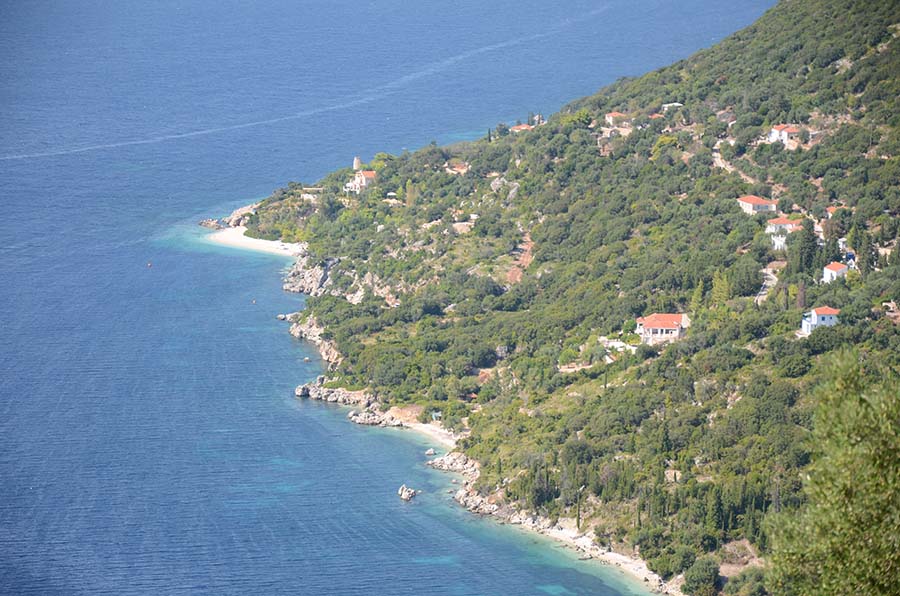
Anogi
This small village has been built on the eastern slopes of Mt. Niritos. The village’s history dates back centuries and it has been a human settlement for more than 6000 years. Anogi was named from the rocky plateau of Niritos which was also called Anogi. Niritos was the name of the first inhabitant of this area and his name has been given to the mountain.
During the Middle Ages, Anogi was well populated as its height, 830 metres above sea level, afforded protection from visiting pirates. There is evidence of an ancient settlement in Agios Ioannis (Sternes), where ruins of an ancient people, dating back to the Hellenistic period, have been discovered. Some of these findings are now exhibited at the Archaeological Museum in Stavros.
Today, there are only about 45 permanent residents of the village although it is much busier and frequently visited during the summer months. As well as enjoying the delightful and impressive views from the village, you can take a walk to the large stone monolith which has been there since the ice age. Pay special attention the one named Araklis, clearly a paraphrase of the name Herakles.
At the heart of the village is the church of the Dormition of the Theotokos, which is quite unique as a monument in Greece and is notable its historically important Venetian bell tower. Within the church, wonderful paintings and icons of saints and angels can be viewed and the quality of work bears witness to the outstanding talents of the iconographer, Antonios from Agrafa , who completed the work in 1680. The key to the church can be taken from the local guardian who is to be found in the only cafe/store in the village.
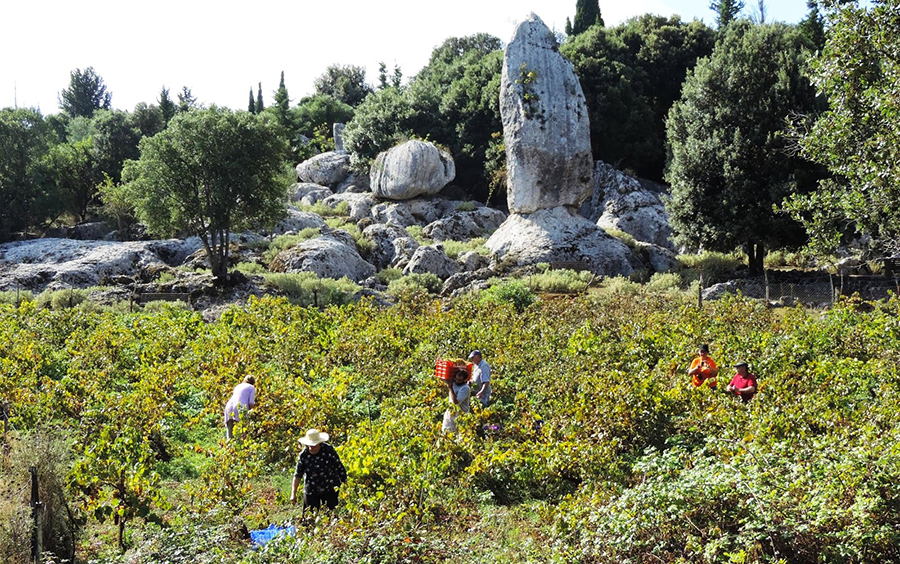
Also worth a visit is the site of the old village, Paxinata, where there is still much evidence of buildings and various small churches. Pathways lead from this area to both Kioni and to Agia Eleousa, higher up the mountain. The historical Monastery of the Panagia (Virgin Mary) of Kathara is only 2.5 km from Anogi. Built around 1696, the monastery is now undergoing an impressive refurbishment and still affords the most unforgettable views from its bell tower and the opportunity to see the icon of the Nativity of the Virgin Mary, who is celebrated and worshipped each September on the eighth of the month.
Exogi
Exogi is the northern-most village of the island. It is built at an altitude of 340 meters on the island’s north-western peninsula and is 22 km away from Vathy. It was founded by the Venetians in the early 16th century and was Ithaca’s third settlement at that time. It was, however, significant due to the safety that its position provided from pirates and its view over the surrounding areas and sea.
Exogi is a very beautiful and picturesque village that offers the visitor tranquility, a special view and direct contact with nature. Today it has 45 permanent inhabitants while in the middle of the 18th century its inhabitants numbered around 1400. It had substantial commercial activity since it produced flax, oil, wine, and raisins. These products were shipped-out from the harbour of Frikes. The land around the village was terraced, creating the ‘hanging gardens’ of Exogi. Thus, no space was thus left uncultivated.
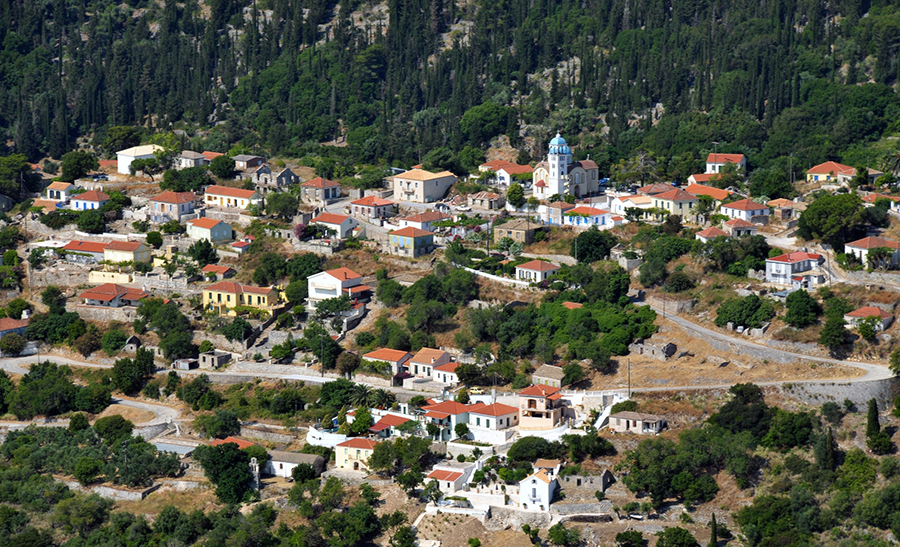
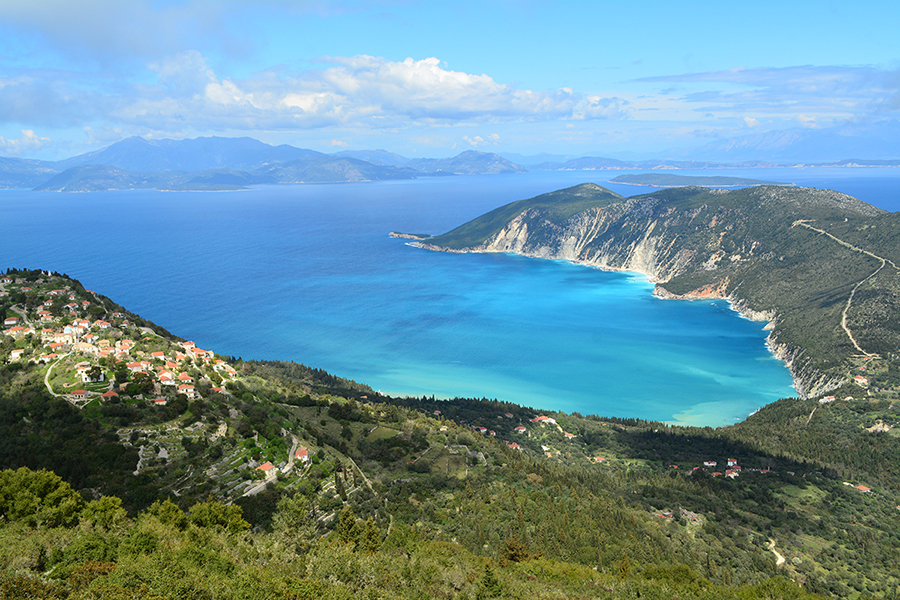
One reaches Exogi by following the road from Stavros to Platreithias. At its highest point, the road veers left and continues uphill towards Exogi. The landscape that unfolds with the ascent, is particularly impressive. The view of the settlement of Platreithias and the sea in the distance with the nearby islands is breathtaking. It’s worth stopping on the flat area that is formed at the ‘Megali Volta’. Here one can admire the view and take excellent photos with the Gulf of Afales and the villages at the foot of the mountain as background. A few meters further, one arrives at the central square of Exogi next to the Church of St Marina. Looking from the square towards the west, one notices the remains of the old village within the gorge that once hid the settlement from the sea because of the fear of pirates. One can also see the terraced slopes that were used for the cultivation of raisins. On July 17 every year, the day on which St Marina’s memory is celebrated, a large festival takes place on the village square, attracting large numbers of people.
Advancing further, one reaches the Church of St Nicholas. Below the flat area in front of the Church are the pyramids of Exogi, built in the 1930s by Ioannis Papadopoulos (John Papas). He was an eccentric millionaire that died without heirs, leaving his wealth to 46 branches of the Red Cross worldwide and appointing the Greek Red Cross as administrator. Visiting Ithaca every now-and-again, he built two pyramids. The southern pyramid is the grave of his parents while the other is a masonic symbol. On the northern side is his grave. Around his grave and in the surrounding area, there are 33 cryptic markings or signs.
Exogi’s attractions don’t stop here! From the flat area in front of the Church, begins the road that leads to what was once the monastery at ‘Pernarakia’. From there the view is incredible and the sunset magical. This is the point from which one can view almost all the villages of Northern Ithaca, the nearby islands, the Aetolokarnania region of the mainland and Kefallonia in the West.
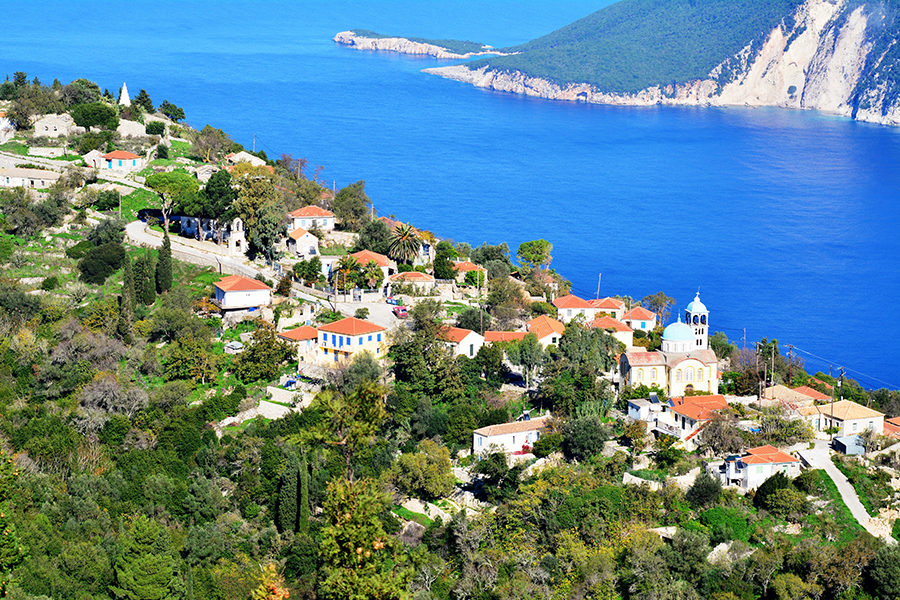
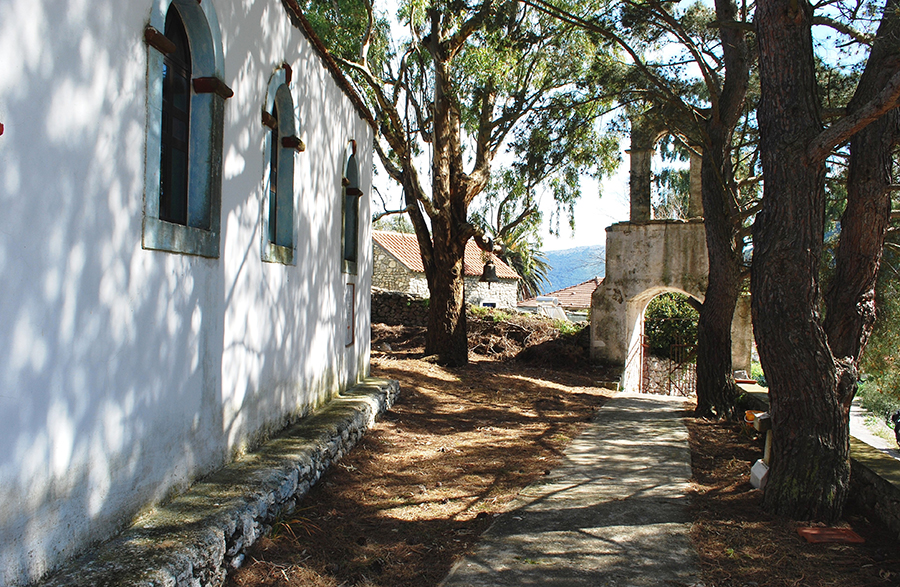
Nature-lovers that enjoy hiking can reach Exogi using the footpath that begins from ‘Gefyri’, the bridge at the center of Platreithias. This path passes through the archaeological site of St Athanasios that contains the Odyssean palace and continues upward, through lush and dense vegetation, to Exogi. It is suggested that one descends using the only path that leads to the spring of Kalamos. These paths were the old roads of the beasts of burden and they are well preserved to this day. It would be an omission if we didn’t mention the wonderful footpath that begins 20 meters before we enter the village, on the left, and leads to the location of Rousano. The vegetation that is almost tropical in density, the view of the village of Stavros and the beach of Polis is unique and leaves the visitor speechless.
Kioni
Without doubt, Kioni is one of Ithaca’s most beautiful villages and one of the most stunning destinations in the Ionian Sea. Its settlement dates from the 16th century, when access to the sea became imperative for the inhabitants of nearby, hillside settlements.
As you approach Kioni, you are greeted by the sight of its small, beautiful bay and by the traditional, well-maintained houses built in the amphitheatre rising from the sea and losing themselves in the woodlands of the surrounding hillsides.
In the months of May to October, the bay and harbour are filled with sailing boats of all sizes, jostling for space among the small boats of the local fisherman.
Arriving by road from Vathy, a distance of 24 km, you enter the village at its highest point, Rachi. To your left is the small cove of Mavronas, which provides a safe refuge for small fishing boats.
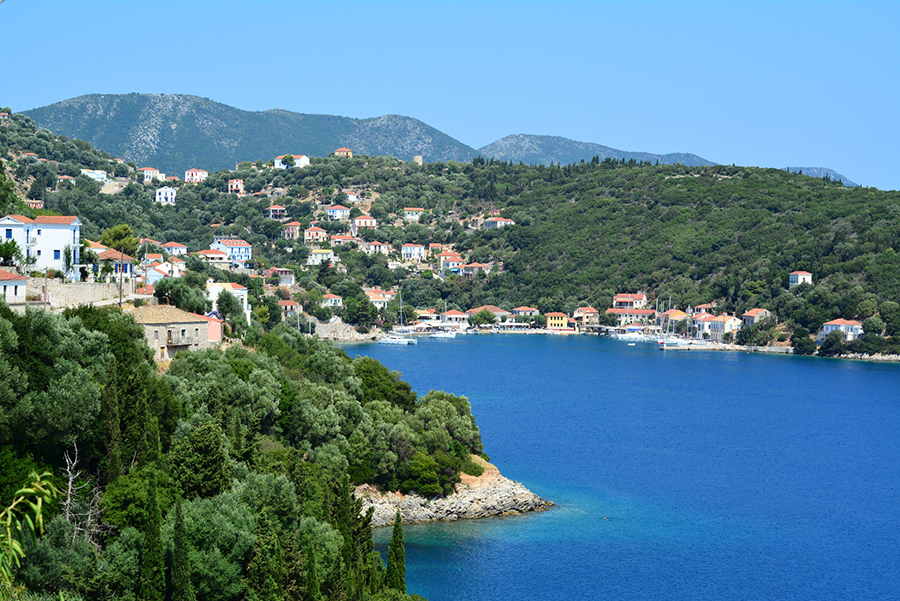
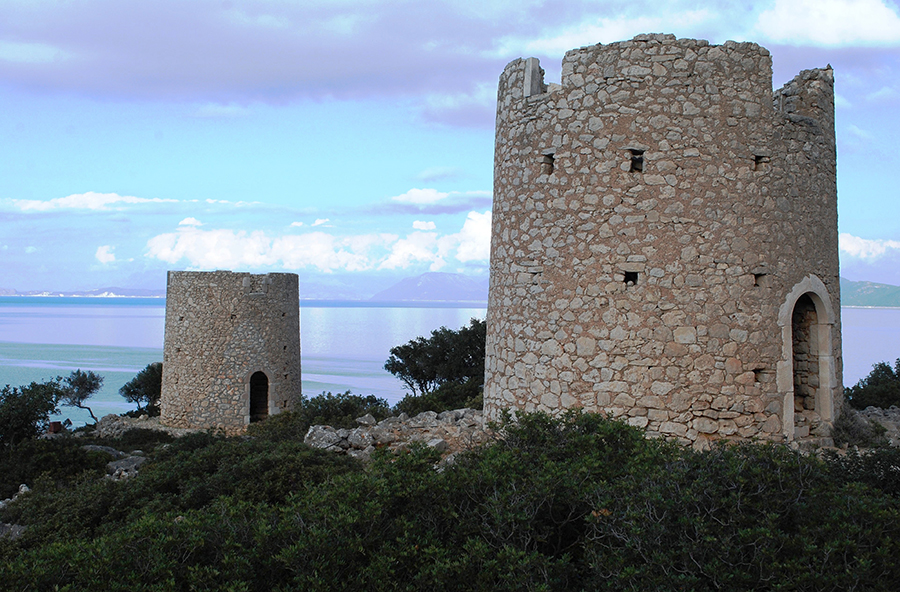
This neighbourhood, where you can now visit a small church, was the site of St. Nicholas’s monastery in the 19th century. Today the church is home to some very ancient columns that are preserved in the altar area. Rachi was also witness, in the 17th century, to a bloody battle where the locals fought off bands of marauding pirates. You can also visit the church of the Evangelistria, built towards the end of the 19th century, home to an interesting altar screen.
Descending into Kioni towards the harbour and the bay, you will pass by the church of Agios Ioannis, well known for the beauty of its wood-carved altar screens. The vista, as you descend, is one of olive trees, cypress trees, and the red-tiled roofs that peek from amongst the lush foliage.
Once at the water’s edge, you can choose from a variety of cafes and restaurants and, in the evening, the three windmills that guard the entrance to the bay are lit up to great effect. A walk towards ‘Argalio’ and the neighbourhood of Loutsa brings you close to the ruins of the home of Georgios Karaïskakis, a hero of the 1821 Greek uprising, and to the pebbled beaches and crystal clear waters of Katsikouli, Sarakinari, Plakoutses and Filiatro—all ideal for a refreshing swim.
Kioni celebrates the festival of the Prophet Elias on the 20th of July every year. On this day, there are morning services at the small church to which worshippers are transported by small boats. The evening celebration is held in the square, close to the water and lasts throughout the night.
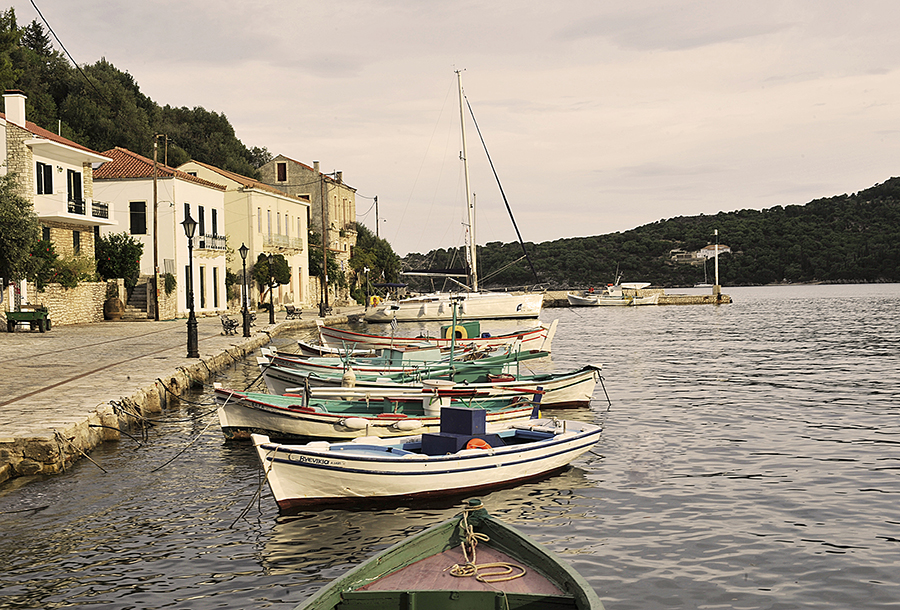
Lefki
Lefki is built on the western side of Nirito Mountain and looks out over the Kefallonian channel and watches the setting of the sun behind Fiskardo on the other side of that stretch of water. The houses are a mix of white painted ones and others with the colours of the hillside into which they are built. Houses have been built on either side of the road joining Stavros to Vathy and their characteristically traditional architecture provide an authentic, island sight for any visitor.
The village is surrounded by small valleys and outcrops which are full of green olive trees and the Redbud ‘Judas Trees’. Pathways lead down from the village, through a verdant landscape, to great rocks on the sea’s edge and to small, secluded beaches of exceptional beauty. Ammoudaki, Kalomoiri sands, and Kaminia are all small beaches with clear blue/green waters which reflect the colours of the sunset as the sun itself disappears towards Fiskardo. A particularly special viewing experience of the sunset can be felt if you take the road from Lefki to Kavos to witness a wild, natural, rugged and magnificent landscape. More active visitors might also want to follow the pathway from the town to the small church of St. George which hosts an annual festival.
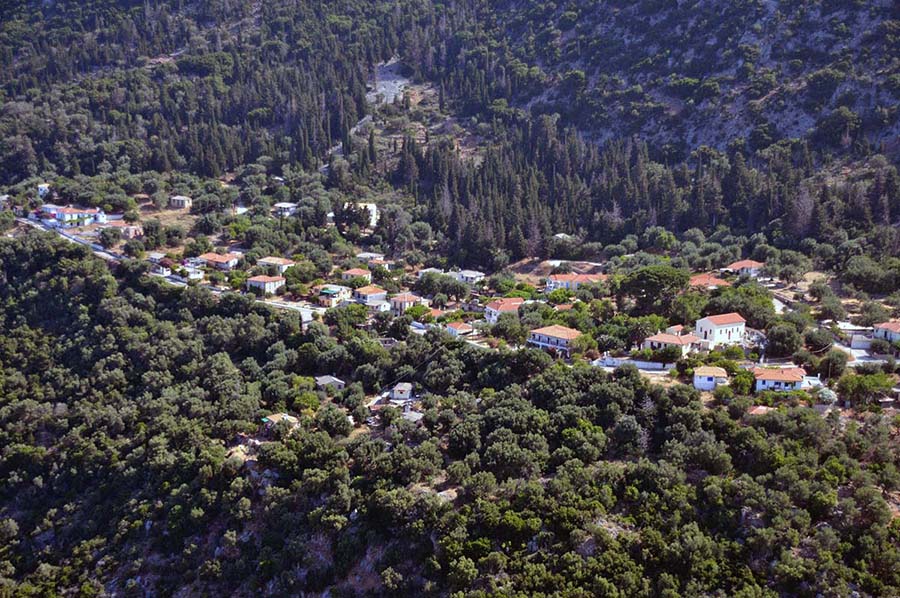
At the church of Theotokos, we can examine the wooden, carved altar screen with evidence of Russian artistic elements which was dedicated to Ulysses by Ithacan migrants at the end of the 19th century. The small church of Agios Vlasios is home to a number of fine post-Byzantine icons.
Perachori
Built as a high amphitheatre, Perachori, is a unique and vibrant village gazing down on Vathy and away, across the sea to the islands of the north and to the mainland. A winding road from Vathy leads visitors to a settlement of well-cared for houses, whitewashed courtyards and gardens full of flowers. As you travel up the road, the views become increasingly impressive and from the highest point at Agnantio you can easily make out Lefkada and Zakynthos.
The villagers of Perachori are known for their hardworking character and lively and welcoming personalities. A good number of them are seamen or farmers.
Visitors can avail themselves of locally produced goods of high quality from the purest of local sources such as wine, olive oil and honey. The local Perachori wine is offered free to visitors at the ‘Wine Festival’ hosted by the village on the final Saturday of every July.
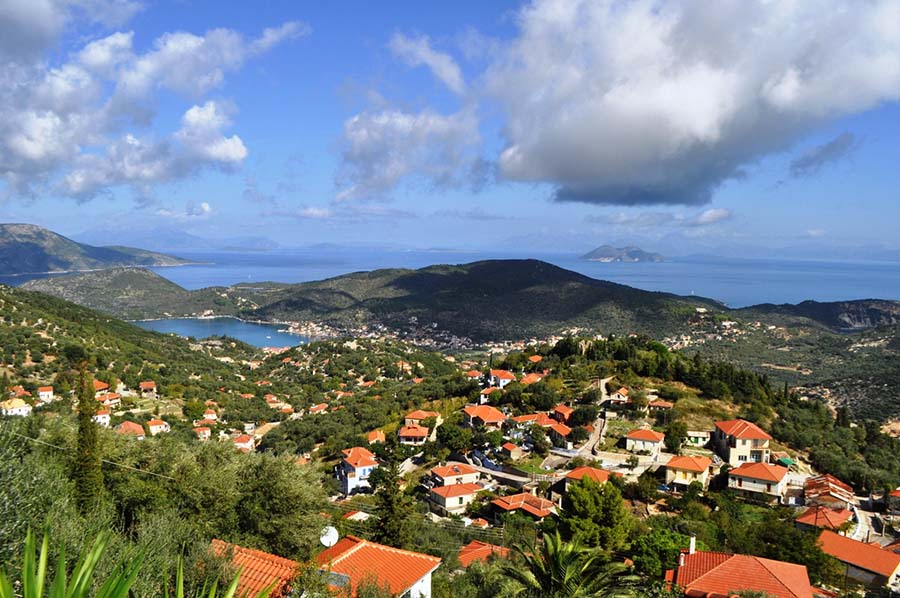
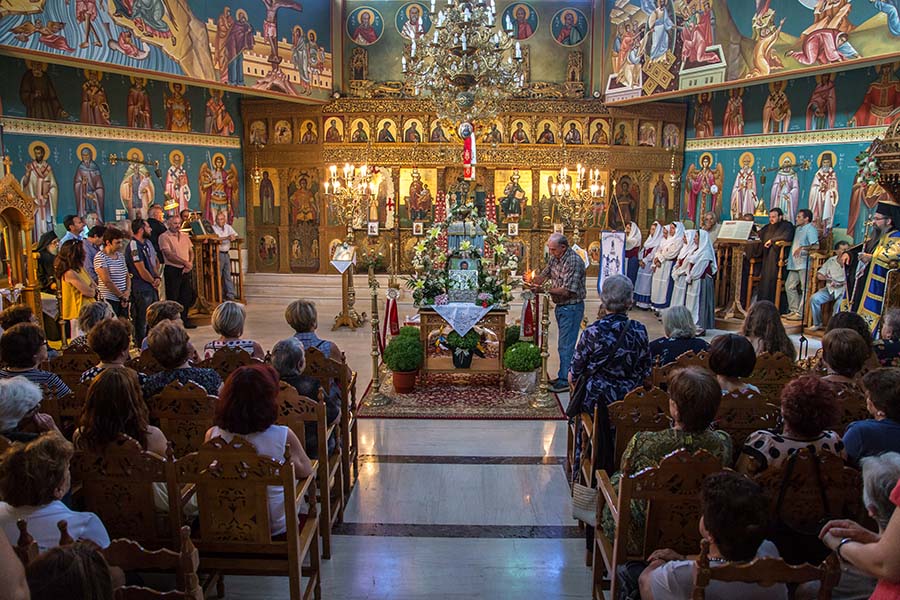
Within easy walking distance of the village we can find the Perachori woods “Afentikos Longos”, a few small, well-cared-for and functioning churches, Taxiarches Monastery and the ruins of the medieval villages of Paleochora and Kounouvato. It is here, in Kounouvato, where St. Raphael was born and a church has been built on the site of his home dwelling and is named for him. In the immediate hinterland of Perachori, Marathia, we can discover and visit a number of sites referenced by Homer—the Fountain of Arethousa, the Raven’s stone perch, the Eumaeus cave and the First Place (Antri).
Platreithias
Platreithias is the most dispersed village on the island of Ithaca. It is to be found in the north, 20 km from Vathy and 2 km from Stavros. It has approximately 210 permanent inhabitants and is made up of smaller settlements-Bouzos or Kanalia, Kollieri, Lofos, central Platreithias, Agii Saranta, Lakos, Misovouno, Marmakas and Frikes. It is very likely that the village takes its name from the dry river which traverses the area and was known as ‘Platy Reithron’.
You enter Platreithias from Kanalia, at the crossroads of the road to Exogi. Your road leads you to the triangle of roads, home of the ‘bridge’ and the only restaurant in this immediate neighbourhood. Taking the road directly to Kollieri you will come across the ‘Nikos Defteraios’ park from where you can enjoy views of Afales Bay and, just a little further along, the open-air Stathis Raftopoulos museum of outdoor artworks.
Further beyond the museum, at Kollieri, the road forks. If you go left, you can visit Upper Kollieri or if you go right, you will come across the only running spring on the island at Kalamos. This clear, fresh water spring has been running for thousands of years and has quenched the thirst of thousands including that of Lord Byron, Heinrich Schliemann, Queen Frederica, Aristotle Onassis and Jackie Kennedy. Walkers can follow a well-maintained pathway from Kalamos to Exogi or another to Perivoli beach in Afales Bay. Local residents are very regular users of both paths as they use them to collect water or go swimming.
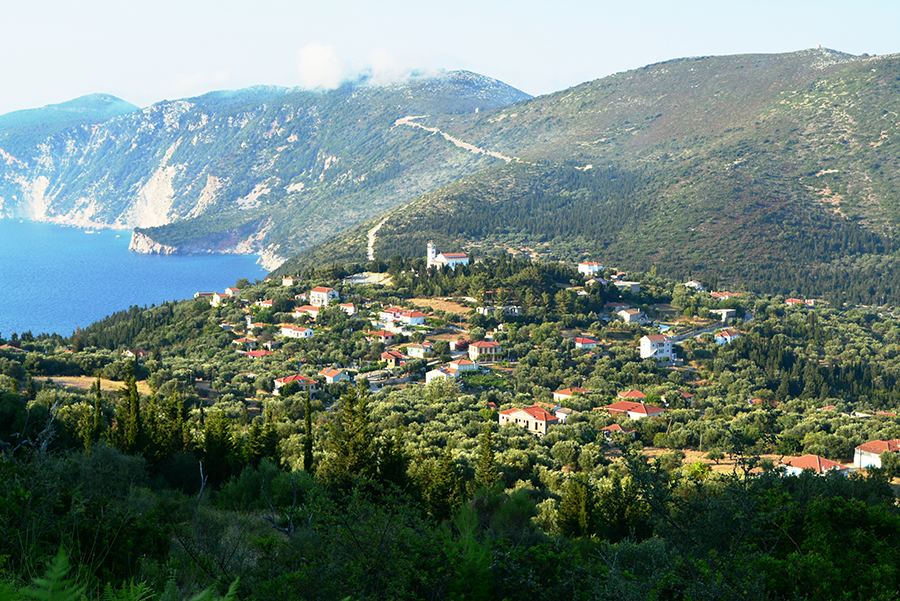
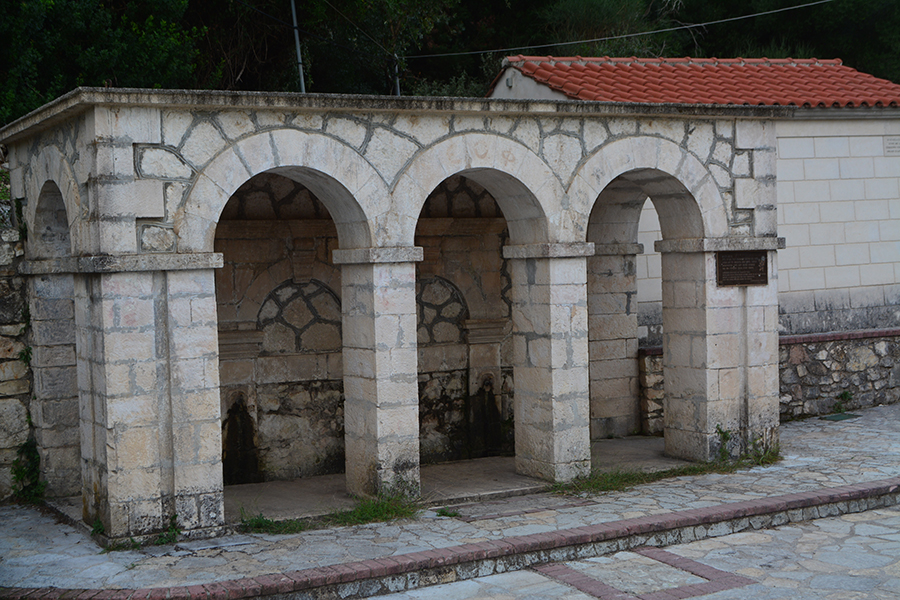
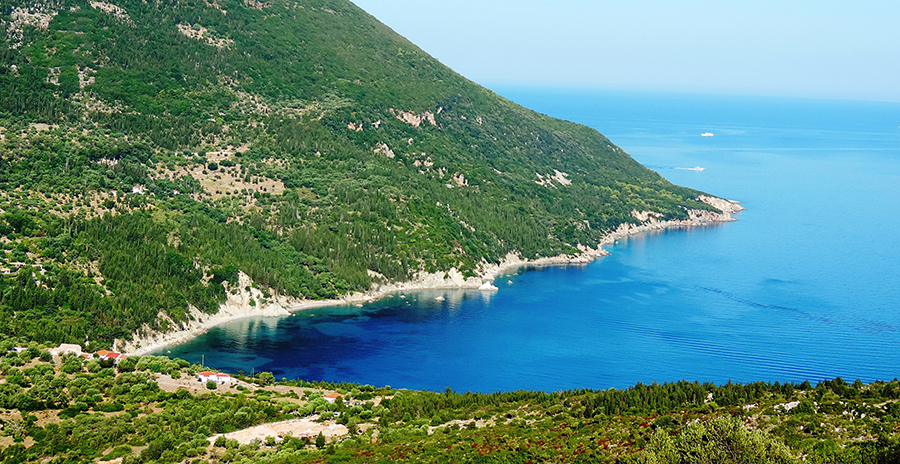
A few metres down to your left from Gefyri, is the road which leads to the beach at Afales. The road to the sea wanders down through almost tropical vegetation before reaching the refreshing, clear sea. The bay itself has a pebbled beach and is embraced by rocky outreaches which hide three secluded smaller beaches, Ammoudaki, Kouloumi and Perivoli. These small beaches and their waters are an ideal place for swimmers to take their first steps as spear fishermen.
A number of other smaller beaches, Platys Ammos, Sykia and Kathisma are only accessible by boat and are everybody’s dream holiday spots. Their turquoise coloured waters, sand and pebble beaches and steep cliffs provide a summer-long attraction for the hundreds of yachts and motor vessels that visit these waters.
To reach the main square, ‘Limnes’, you should follow the main road from Gefyri. This central square plays host to a series of cultural events during the summer highlighted by the celebrations for August 15th, Dormition of the Virgin Mary-Panagia, which attracts large crowds. Just beyond the square is a small rise, Taxiarches, with the church of the same name, offering gorgeous views over the village to Afales Bay.
The next neighbourhood is Agioi Saranta where you can wonder at the work of the Italian architect and ironist Bruno Mazzali, which covers almost all of the interior walls of the local church.
Following the road ‘down’, you come to the road which will lead to Panagia in Skala. This short journey ‘takes your breath away’ as it opens full vistas to the magnificent Afales Bay. You can also visit the only remaining functioning windmill on the island. Just beyond is the small church of Panagia which celebrates every 15th of August when, following the service, local cultural groups offer the congregation and visitors servings of goat, sweets and refreshing drinks. Those who stay beyond the afternoon are rewarded by a most breath-taking sunset best seen from the windmill.
The best way to continue your journey to Alykes and Marmakas beaches is in a 4×4 vehicle. Both are small-pebbled beaches with tall eucalyptus trees offering shade and a common view of the island of Agios Nikolaos. In the summer season a small canteen operates to care for the needs of visitors who can also reach here by driving from Frikes…but, only in a suitable vehicle as the road can sometimes be difficult!
No introduction to Platreithias would be complete without making reference to the Archaeological site of Agios Athanasios also known as ‘Homer’s School’.
Follow the road to Exogi and after 100 metres or so a right turn takes you to a dirt road leading to the heights of Exogi and to Platreithias. It is here that you will find Homer’s School, ancient remains of primarily Mycenaean buildings. Litsa Kontorli-Papadopoulou, emeritus professor of the University of Ioannina, who carried out the excavations, declared in August 2010 that this is indeed the site of Ulysses’ Palace. His palace includes rooms built on two levels. It features a stone entrance step and an internal double set of stairs, underground food warehouses, mosaic flooring, underground water supplies and drains as well as external walls. The surrounding area has been classified as a site of important archaeological interest and the land is now owned and the site maintained by the Hellenic Ministry of Culture, Education and Religious Affairs.
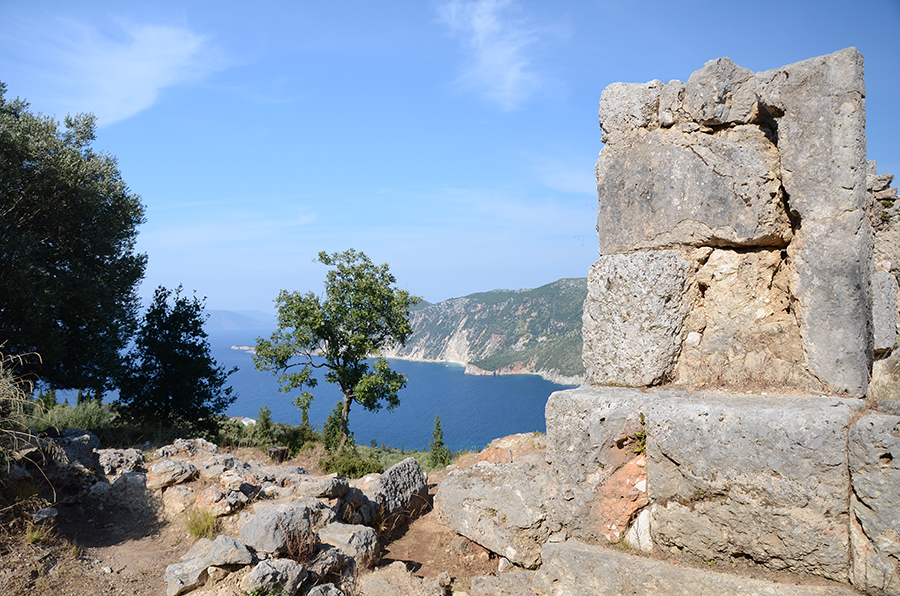
Stavros
Seventeen kilometres from Vathy, Stavros is the main village of north Ithaca and the area’s commercial capital. Full of architecturally outstanding buildings and dwellings of the rich merchants from previous centuries, Stavros is an ideal holiday base for those wishing to explore both mountain and seaside locations.
The village’s central square has quite a unique character. We can find the Byzantine church of the Saviour, a lovely little public park with a bust of Ulysses and, quite surprisingly, a small reproduction of Odysseus’ Palace, a work by the Italian architect, Bruno Mazzali. Close by the square is a fine example of architecture dating back to the British occupation, a building known as the Palace of Tzani.
The restaurants and coffee shops in and around the square are scattered amongst the green pine and eucalyptus trees providing shade for those visitors sampling local traditional sweets and enjoying the traditional Ithacan cuisine. It is in this square, every year on 5-6 August that the island’s largest festival is held to celebrate the Transfiguration of the Saviour. Tourists, visitors and locals need two days and nights to properly enjoy this celebration!!
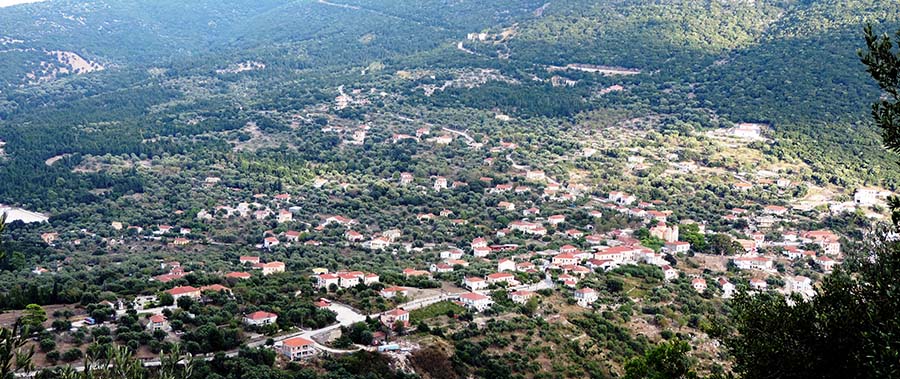
Pilikata hill, just north of Stavros, where the Archaeological museum can be found, is a designated area of Archaeological interest and value. In the opinion of W. A. Heurtley, it is here where Ulysses had his main palace and home and a good number of relics and remains found here have supported that argument.
Polis Bay lies just below Stavros at a distance of 1.5 km from the main square. This picturesque refuge for fishing boats is now also home to a long and organised bathing beach. But, there is plenty of cool shade provided by the tall pine and cypress trees which come so close to the water’s edge.
Polis takes its name from the ancient settlement which is to be found sunk in the bay’s waters. It is very probable that this group of buildings is the Jerusalem, which Anna Komnene refers to in her work, the Alexiad, and which collapsed as a result of a major earthquake in 967 B.C. At the northern edge of the bay are found the remains of the collapsed cave of Loizos. This cave was used as a place of worship, probably from 2500 B.C., but certainly from Mycenaean to Roman times. Archaeological findings confirm that this cave also served as a place of worship to Odysseus and his name has been found engraved on shell and clay remains as well as on fragments of a mask of a woman of the second century B.C. which contains the phrase ‘EYXHN ODYSSEI’ or ‘“Pray to Odysseus” .
Frikes
Frikes is to be found in the northwest of Ithaca, 19 km from Vathy, 5 km from Kioni and 3 km from Stavros. The village was first inhabited in the 16th century when the inhabitants of the surrounding hills began to use the natural harbour of Frikes as their fishing base but mainly to conduct commercial and trading activity with Lefkada and with mainland Greece. According to some academics, Frikes is the harbour referred to by Homer as Reithron.
This very picturesque fishing village is now a significant tourist destination with a fair number of established hotels and guest houses. During the summer there is a daily boat service to and from Lefkada. In addition, there are facilities for the repair, maintenance and supply of sailing boats and leisure motor boats, thus providing an ideal base for visiting the beautiful nearby beaches and for exploring the sea and beaches to the north of the island.
During the summer, the bay of Frikes can be subject to quite breezy conditions. This local, northwest wind creates ideal conditions for sailing and for windsurfing.
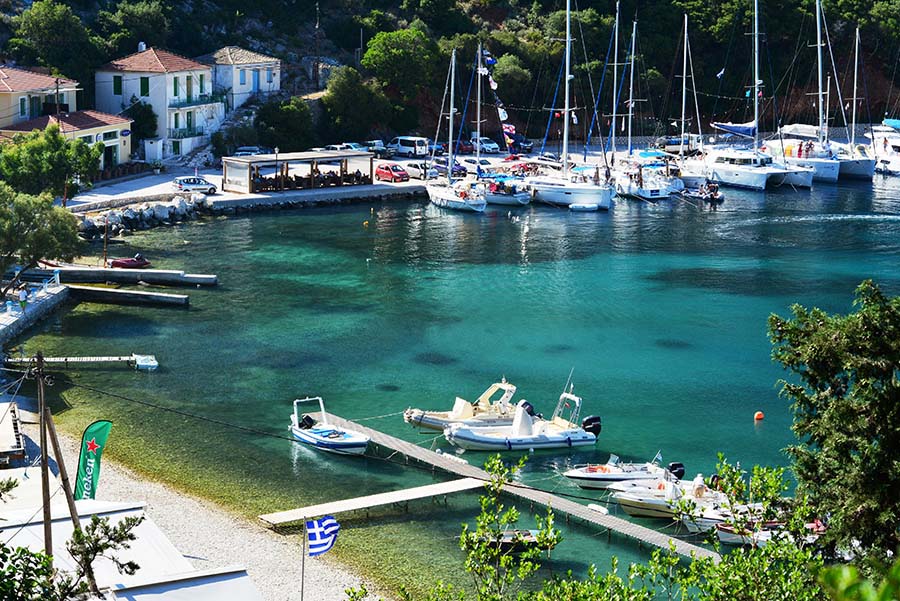
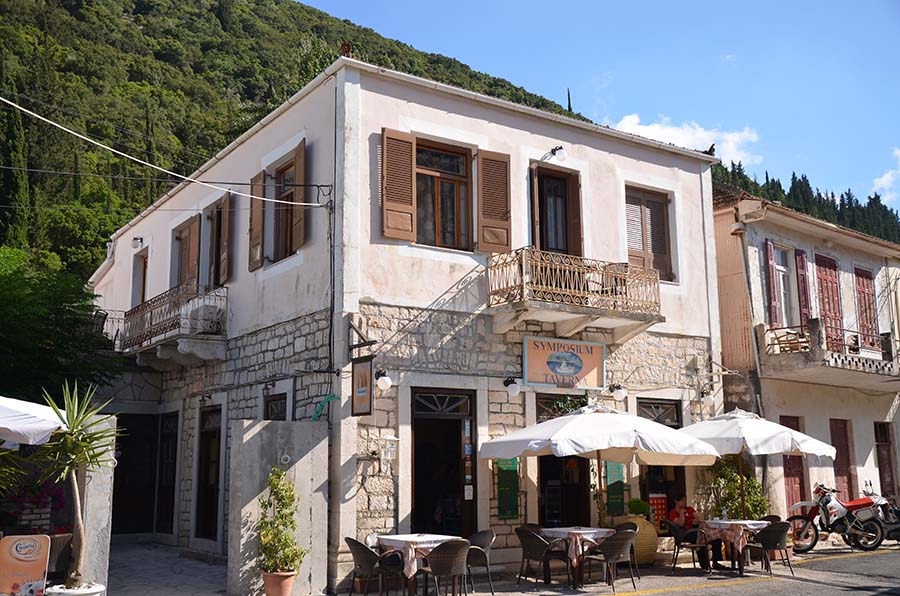
Frikes is home to two particularly well-maintained windmills that look down on the harbour. At night they are illuminated for all to see, especially those visitors dining at one of the various seaside fish restaurants or enjoying a drink or sweet at one of the many cafes to be found here. Those visitors, lucky enough to be in Frikes on June 30th, can enjoy the celebratory festivities held to honour the Holy Apostles.
If you follow the dirt road from Frikes towards the wild beauty of Marmakas, you can enjoy a wonderful swim and visit the unique bio-diverse wetlands of Ithaca, at Alykes. Travelling away from Frikes towards Kioni, accompanied by the sea to your left and the green hills to your right, you will experience a truly beautiful journey, one of the most pleasurable in any of the Ionian islands.






